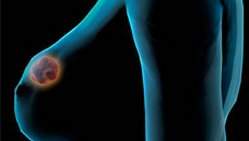 |
A pesquisa brasileira identificou proteínas que servem como indicadores que poderão melhorar a eficiência da quimioterapia e, assim, a resposta ao tratamento. |
Expressão de proteínas
Novas perspectivas para se conhecer a evolução do câncer de mama e novos caminhos que poderão melhorar a eficiência da quimioterapia e, assim, a resposta ao tratamento.
Estes são os resultados de uma pesquisa realizada na Faculdade de Medicina de Ribeirão Preto (FMRP), da USP.
Os estudos investigaram a expressão, ou seja, a presença de duas proteínas, a HIF-1-alfa (fator induzível por hipóxia-1-alfa) e a VEGF-C (fator de crescimento endotelial vascular), em mulheres com câncer de mama localmente avançado.
Segundo os pesquisadores Luiz Gustavo Brito e Viviane Schiavon, ao analisarem a presença do HIF-1-alfa e do VEGF-C nessas mulheres, verificou-se que o primeiro teve prevalência de 66% e o segundo de 63%.
Enquanto o HIF-1-alfa esteve mais intenso, ou seja, apareceu mais em mulheres com axila comprometida pelo câncer, o VEGF esteve mais presente naquelas que fizeram quimioterapia e cuja resposta foi boa.
"Isso quer dizer que, quanto mais agressivo era o câncer, mas presente o HIF-1-alfa estava, enquanto o VEGF está relacionado à resposta ao tratamento nessas mulheres", explica Brito.
Caminhos para o tratamento
Para os pesquisadores, futuramente o HIF-1-alfa poderá ser usado como indicador que dirá qual vai ser o prognóstico da mulher com câncer de mama, ou seja, como será a sua evolução.
Já o VEGF-C terá um papel importante nas mulheres que farão quimioterapia.
"A quimioterapia funcionou melhor nas pacientes cujo tumor expressou o VEGF, o que sugere que o tumor, ao aumentar a produção de vasos por esta proteína, aumenta a chegada da droga até o leito, matando essas células", diz Viviane.
Os pesquisadores trabalharam somente com mulheres com câncer localmente avançado e metastático.
"Ao contrário dos países desenvolvidos, onde as mulheres descobrem o câncer precocemente, no Brasil, por exemplo, devido ao retardo no diagnóstico, os tratamentos são feitos em estágios mais avançados da doença, às vezes sem cura. Todas as mulheres pesquisadas já haviam se submetido à quimioterapia e à cirurgia," explica a pesquisadora.
Tratamento individualizado
A HIF-1-alfa é uma proteína descoberta recentemente e ainda pouco conhecida da ciência.
Brito diz que pesquisas já têm mostrado que futuramente ela será utilizada para saber qual o perfil do câncer de mama da paciente, se é agressivo o não. "Aí é que entra nossa contribuição. Cada vez mais o tratamento do câncer de mama é individualizado, baseado no comportamento tumoral específico daquela paciente".
Já Viviane, responsável pela investigação do VEGF-C, adianta que essa proteína já é estudada há mais de 50 anos.
"Mas estudos com grupo de mulheres com câncer de mama localmente avançado são poucos e menos ainda aqueles que mostram o seu comportamento, mas ela só deverá ser utilizada como marcador futuramente para predizer uma boa resposta à quimioterapia, assim como pelo uso de drogas que bloqueiem sua ação", resume.
Câncer de Mama no Brasil
Segundo dados do Instituto Nacional do Câncer (INCA) para 2010 eram esperados 49.240 novos casos de câncer de mama, ou seja, um risco estimado de 49 casos a cada 100 mil mulheres.
Ainda, de acordo com o INCA, na Região Sudeste, o câncer de mama é o mais incidente entre as mulheres, com um risco estimado de 65 casos novos por 100 mil.
Sem considerar os tumores de pele não melanoma, este tipo de câncer também é o mais frequente nas mulheres das regiões Sul (64/100.000), Centro-Oeste (38/100.000) e Nordeste (30/100.000). Na Região Norte é o segundo tumor mais incidente (17/100.000).
Entretanto os pesquisadores alertam que a chance de cura para o câncer de mama pode chegar a mais de 95% se descoberta em estágios iniciais.
O Instituto Nacional do Câncer recomenda que as mulheres a partir dos 50 anos de idade façam mamografia uma vez a cada dois anos.



 A próxima reunião do Movimento da Reforma Sanitária será realizada amanhã, 24 de fevereiro, às 17h, no Núcleo de Estudos de Saúde Pública (
A próxima reunião do Movimento da Reforma Sanitária será realizada amanhã, 24 de fevereiro, às 17h, no Núcleo de Estudos de Saúde Pública ( O Presidente da ABRASCO, Luiz Augusto Facchini, concedeu entrevista ao
O Presidente da ABRASCO, Luiz Augusto Facchini, concedeu entrevista ao  Lígia Bahia e Luis Eugênio Portela Fernandes de Sousa, vice-presidentes da ABRASCO, participaram da 218ª Reunião Ordinária do Conselho Nacional de Saúde (
Lígia Bahia e Luis Eugênio Portela Fernandes de Sousa, vice-presidentes da ABRASCO, participaram da 218ª Reunião Ordinária do Conselho Nacional de Saúde ( O assessor regional sênior em Sistemas de Saúde e Serviços da Organização Pan-Americana da Saúde/Organização Mundial da Saúde (
O assessor regional sênior em Sistemas de Saúde e Serviços da Organização Pan-Americana da Saúde/Organização Mundial da Saúde ( O número temático de fevereiro da
O número temático de fevereiro da 



